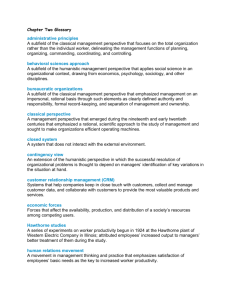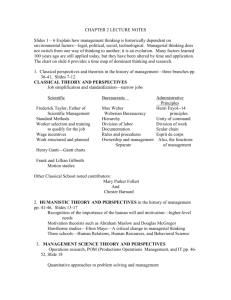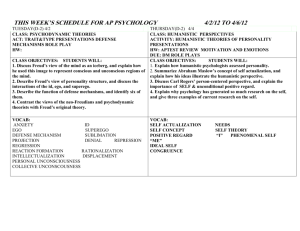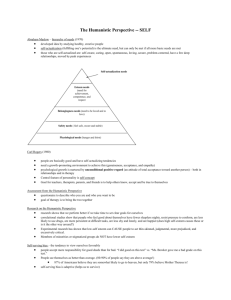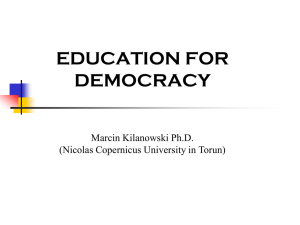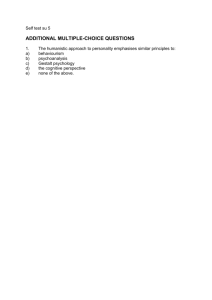Foreign languages - Conseil de l`Europe
advertisement
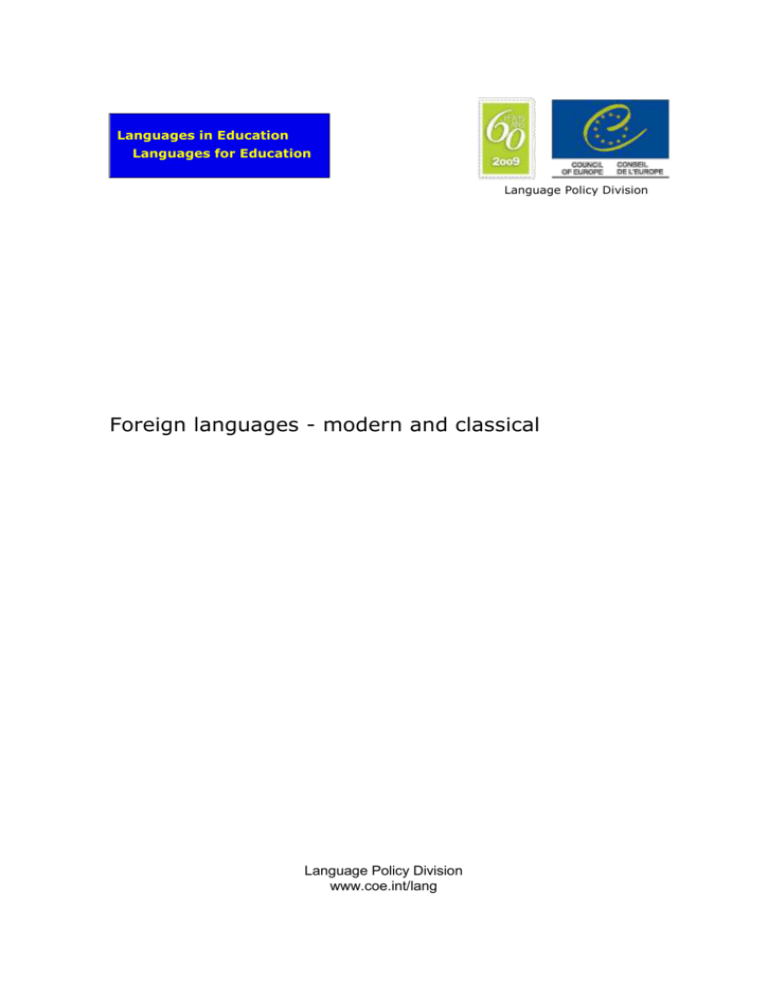
Languages in Education Languages for Education Language Policy Division Foreign languages - modern and classical Language Policy Division www.coe.int/lang Ad-hoc coordination group for the platform : Laila AASE, Jean-Claude BEACCO, Michael BYRAM, Marisa CAVALLI, Daniel COSTE, Alexandru CRIŞAN, Michael FLEMING, Olivier MARADAN, Sigmund ONGSTAD, Irene PIEPER, Florentina SAMIHAIAN, Helmut VOLLMER and Piet-Hein VAN DE VEN Editorial board: Jean-Claude BEACCO, Michael BYRAM, Daniel COSTE and Michael FLEMING Foreign languages - modern and classical Classical and modern foreign languages have educational goals which are both humanistic and utilitarian. The discourse on the teaching both groups of languages reveals this and also the differences in emphasis between them. The Council of Europe has produced instruments which enable the improvement of teaching, learning and assessment of modern foreign languages. List of contents 1. Humanistic purposes ........................................................................................ 4 2. Functional purposes ......................................................................................... 5 3. Council of Europe instruments for creating a common language for language teaching ............................................................................................................ 6 Language Policy Division 3 This text is an introduction to that part of the platform which deals with the languages in education which are usually designated as modern languages and classical languages and which have in common their differentiation from the dominant language(s) of an education system which are also the majority language(s) of a society -- the "national" language(s). This differentiation means that what both modern and classical languages have in common is that they are "foreign" languages, not normally used within a society. They are the means of access to other societies and their (multiple) cultures whether contemporary or historic. Classical and modern foreign languages as subjects in compulsory schooling have some educational purposes in common and others which differ. They share purposes focused on knowledge and understanding of the nature of language, of other cultures and of learners’ own. To a lesser extent they share the purpose of learning to communicate with people speaking other languages. In the case of classical languages, communication is receptive whereas in modern languages it is both receptive and productive. In the classical languages, educational purposes are humanistic whereas in modern languages they are both humanistic and utilitarian or pragmatic, as is also the case in the languages of schooling Until recent decades, modern language teaching was concerned only with languages spoken outside the country in which they were being learnt – ‘foreign’ languages. As societies have become more complex and new languages are introduced to countries by immigrant groups – or more attention is paid to languages long present but hitherto ignored – the notion of modern languages has extended to languages present in a country but not considered to be ‘national’ languages. Some of these languages have become a component of the panoply of languages taught in schools. Some of these languages may be perceived as ‘foreign’ and others as part of the cultural heritage. The distinction is blurred but the fundamental purposes remain the same. Foreign language teaching is thus a matter of extending learners’ repertoire of languages and language varieties – their plurilingual competence – and giving them the potential to continue to extend their repertoire throughout life, autonomously or with the help of teaching. Foreign language teaching is thus part of education for plurilingualism with many features in common with the teaching of other languages of education and a potential for cooperation as a principle of curriculum design. 1. Humanistic purposes In both classical and modern languages, teachers intend that learners should become able to use the language in question and also that they should become aware of its nature through study and analysis. The relationship between use and analysis is an issue on which consensus has not been reached, but the value of each is emphasised in curriculum documents and discourse. The results of study and analysis of a specific language are also expected to be transferable to other languages as learners apply their knowledge and skills to new languages they encounter throughout life. This is a contribution to the promotion of lifelong learning and plurilingual competence. Study and analysis of languages is, secondly, a means to understanding the nature of language itself and of people as language beings. (This is often referred to as teaching for "language awareness"/ “awareness of language”.) This is a contribution to humanistic education in the sense of the understanding of humanity and in the sense of the individual's understanding of self. Language Policy 4 Language teaching also focuses on cultures associated with the language in question in order to achieve other humanistic goals, namely understanding of people of other societies and their cultures. Understanding of cultures, combined with opportunities for communication, is expected to lead to a reduction of prejudiced views of others. Since communication in modern languages can be both receptive and productive and immediate rather than mediated through texts, this educational goal has, in the recent decades, been given more emphasis than in classical languages. In modern languages, policy and teaching thus focuses on ‘intercultural competence’ – the willingness and ability to engage with people of other languages in common pursuits – which has humanistic consequences in the form of reflection on one’s own cultures and identities as well as utilitarian consequences since it enables direct interaction with people of other languages and cultures. 2. Functional purposes The teaching of modern languages in Europe grew out of the teaching of Latin which in the middle ages had functional or utilitarian purposes. The loss of utilitarian purposes in the classical languages led by contrast to a greater emphasis in modern languages on such goals: to communicate with speakers of these languages in order to trade, find work and exchange views on common interests. In recent decades this greater emphasis has tended to exclude humanistic goals in practice, although the humanistic and functional goals are not mutually exclusive in principle: better communication is also an objective for better understanding among people of different languages and cultures. One manifestation of this dual focus (functional and humanistic) is in the inclusion of "communication in foreign languages" as a key competence in the Common European Framework of Reference for Languages: learning, teaching, assessment (CEFR). The focus on functional goals has also led to changes in methods of teaching and learning which put more emphasis on language use and less on the analysis of language and, as a consequence, on the humanistic values of language analysis. New methods - collectively labelled as a "communicative language teaching" approach - are related to a change in the ways of analysing language for teaching and learning syllabi. There is a greater emphasis on the "functions" which language can be used for and the "notions which it can be used to express, although this does not exclude attention to syntax and phonology as part of a syllabus for learning and teaching. At the Council of Europe, this led to the production of ‘threshold levels’ i.e. descriptions of the language to operate successfully in another language for everyday needs. Communicative language teaching methods also increase attention to language use as a mode of language learning. Learners are encouraged to use their language competence however limited to engage with other users, in exchanging views or information for example. This takes place in the languages classroom but has also been extended to other classrooms through the use of modern foreign languages as media of teaching and learning of other subjects in the curriculum, such as natural sciences (e.g. biology) and social or human sciences (e.g. geography) – referred to as ‘Content and Language Integrated Learning’ or, where all subjects are taught through a modern foreign language, as ‘immersion programmes’. This development brings the role of modern languages into a relationship with the languages of schooling as used in other subjects. Language Policy 5 3. Council of Europe instruments for creating a common language for language teaching Changes in European society in the second half of the 20th century have made language learning more important than ever. Humanistic goals of understanding others, their cultures and their cultural heritage are more important in the promotion of social cohesion within European states and within Europe as a whole. These goals have inspired the language projects of the Council of Europe since the beginning and are reflected in its White Paper on Intercultural Dialogue. Functional purposes have also become more important because of the increased geographic mobility of the workers and students and more comprehensive flows of migration within and from outside Europe. Mobility and migration lead to immediate and direct experience of others instead of that which is mediated through the texts and which was previously at the core of language teaching. Those who have this experience can benefit from instruments which help them to analyse and reflect on it. Both learners and teachers - and others professionally engaged in language teaching - can benefit from a means of talking about their language use and the multiplicity of approaches to teaching and learning. The Council of Europe’s European Centre for Modern Languages (www.ecml.at) provides a means of doing this through a programme of activities of research and development in methodologies, curriculum innovation and policy implementation. The Language Policy Division of the Council of Europe has for several decades worked to analyse language needs in Europe as it changes over time, fulfilling the expectations set out in the European Cultural Convention (Article 2) that the study of languages is a crucial element in creating European cooperation and harmony. A major outcome of this work is the Common European Framework of Reference for Languages (CEFR), an instrument which provides a common basis for the elaboration of language syllabuses, curriculum guidelines, examinations, textbooks, etc. across Europe. It is widely used in Europe and other continents and its impact on policy and practice has been demonstrated. One of the applications of the CEFR is in the sphere of assessment and certification where a common basis for comparing and systematising examination processes and judgements of competence is in high demand. A Manual for relating Language Examinations to the CEFR and a wide range of related documents and illustrative material are available from the Language Policy Division. The European Language Portfolio is a practical tool to support the individual learner in developing and demonstrating his/her plurilingual repertoire at school and in life-long learning. The Guide for the Development of Language Education Policies in Europe is another instrument to help those who decide on language teaching policy at any level of an education system, from ministerial decisions to school and classroom decision-making. The Language Education Policy Profiles is an activity to support member states in analysing and planning their language education policies. Language Policy 6
